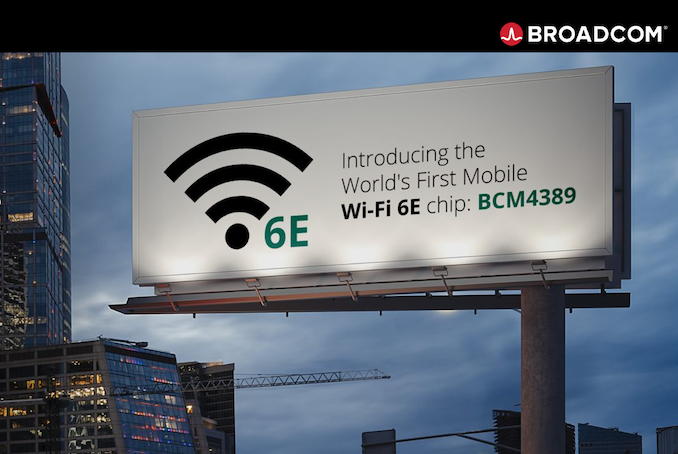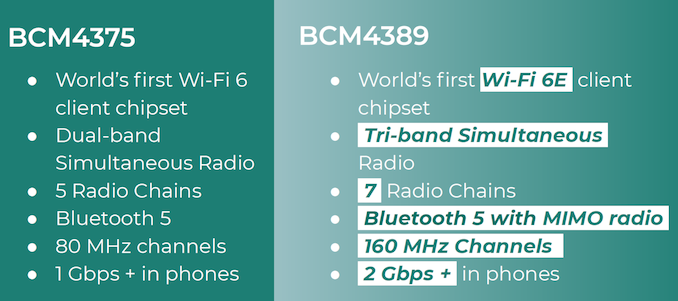Broadcom Announces BCM4389 Wi-Fi 6E Client Chipset
by Ganesh T S on February 13, 2020 5:00 AM EST- Posted in
- Networking
- Broadcom
- Bluetooth
- Wi-Fi 6E
- 6 GHz

The Wi-Fi Alliance announced the new Wi-Fi 6E terminology for 802.11ax operation in the 6 GHz band last month. At CES 2020, Broadcom announced a number of Wi-Fi 6E access point solutions. Today, Broadcom is announcing the BCM4389 client Wi-Fi 6E chipset. Consumers can expect to see the chipset in the next generation of high-end smartphones. We have already covered the advantages of Wi-Fi 6E in terms of lower latency, higher throughput, and the availability of more number of 160 MHz channels in our coverage of the Wi-Fi Alliance announcement at CES.
The BCM4389 builds upon Broadcom's success with the BCM4375, which happens to be the currently leading client Wi-Fi 6 chipset in the smartphone market. In addition to the new 6 GHz support with tri-band simultaneous operation and 160 MHz channel support, the BCM4389 also brings in additional power efficiency, thanks to its 16nm process technology and architectural improvements.
The BCM4375 is a 28nm chipset with 2x2 2.4 GHz and 2x2 5 GHz support, while the new BCM4389 adds 2x2 6 GHz to the mix. The scanning radio accounts for the additional radio chain.
The Bluetooth 5.0 functionality has also received a boost with MIMO support. Broadcom claims that the new implementation can reduce pairing time by a factor of 2 and also alleviate glitching issues when connected to Wi-Fi at the same time (compared to the BCM4375). The icing on the cake is that the MIMO support works with implicit beamforming ensuring that legacy Bluetooth devices stand to benefit too.
Silicon vendors like Broadcom and Qualcomm have been finding it relative straightforward to add 6 GHz support to their existing 802.11ax product lines. Qualcomm has not yet publicly announced Wi-Fi 6E products, though they did talk a lot about being ready for it at their Wi-Fi 6 Day last year. Broadcom, though, seems to have taken the lead with public announcements. Thanks to silicon availability, device vendors should be able to easily push out Wi-Fi 6E support in their products once the FCC clearance is in place. For consumers, the power efficiency improvements along with tri-band simultaneous operation should be very welcome news.

















18 Comments
View All Comments
ksec - Thursday, February 13, 2020 - link
160Mhz, 6Ghz, Tri Band? I hope OFDMA is also fixed. ( Or we can ignore it in 2.4Ghz which is what is causing problem from I heard )Finally all these optional features are standard, at least in Apple Ecosystem which uses Broadcom. ( Cant remember what they use on Mac )
All these are very welcome news.
yeeeeman - Thursday, February 13, 2020 - link
samsung also uses broadcom on galaxy s line.haukionkannel - Thursday, February 13, 2020 - link
Just when we did get customer friendly Wi-Fi 4 Wi-Fi 5 Wi-Fi 6 names... we get Wi-Fi 6e... and that is how it begings... soon we have 6c, 6i, 6x... and nobody knows what is best and what is compatible with what.GreyFox7 - Thursday, February 13, 2020 - link
They just can't help themselves. Should you need further proof go look at USB standards if you dare to call USB Burgoo a standard where they throw everything in the pot and simmer.danjw - Thursday, February 13, 2020 - link
That was exactly what I was thinking when I saw WiFi 6e. WiFi 6x Gen 4 2x2 for the win. ;-)yeeeeman - Thursday, February 13, 2020 - link
It is 6e because it means extended. This is wifi 6 with the added capability of working on 6Ghz band. No reason to move to wifi 7 for this.peevee - Thursday, February 13, 2020 - link
It should have been 6G from the start. :)levizx - Wednesday, February 19, 2020 - link
WiFi 6e is exactly the same as WiFi 6 on the same band, the only difference is the added band. Why would they use a new name?mooninite - Thursday, February 13, 2020 - link
Is 160MHz usable with Wifi 6 in the USA? I ask because it is impossible to use 160MHz in the USA for Wifi 5. Not only is it due to lack of client support but the FCC/Military restrictions on it don't allow it to work.edtasdf - Thursday, February 13, 2020 - link
This article says the FCC will have to clear it first.